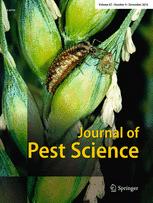Ver ítem
- xmlui.general.dspace_homeCentros Regionales y EEAsCentro Regional Patagonia NorteEEA BarilocheArtículos científicosxmlui.ArtifactBrowser.ItemViewer.trail
- Inicio
- Centros Regionales y EEAs
- Centro Regional Patagonia Norte
- EEA Bariloche
- Artículos científicos
- Ver ítem
Genetic assessment of the invasion history of Drosophila suzukii in Argentina
Resumen
Drosophila suzukii (Diptera: Drosophilidae) is a highly polyphagous fruit pest native to eastern Asia, which in the last decade had widely expanded its range and become a serious pest in the Americas and Europe. Invasion routes and the genetic diversity in populations of South America are poorly studied. Here, we compared the patterns of genetic variation of native populations and previously invaded regions (in America and Europe) with the genetic
[ver mas...]
Drosophila suzukii (Diptera: Drosophilidae) is a highly polyphagous fruit pest native to eastern Asia, which in the last decade had widely expanded its range and become a serious pest in the Americas and Europe. Invasion routes and the genetic diversity in populations of South America are poorly studied. Here, we compared the patterns of genetic variation of native populations and previously invaded regions (in America and Europe) with the genetic diversity of the recent invasion in Argentina. In addition, we explored the regional trade routes and volume of host fruits (Argentina, Brazil, Chile and Uruguay) to understand propagule pressure. We report for the first time a genetic assessment of the invasion history of D. suzukii in Argentina, noting genetic diversity at Cytochrome c oxidase subunit I gene fragment comparable with other recently colonized countries. In the years prior to the invasion into South America, Brazil imported large quantities of potential host fruits from different countries that had been previously invaded; likely Brazil might be the main source of D. suzukii in Argentina. This is emphasized by the fact that Argentina and Brazil share haplotypes; however, direct commercial pathway with the USA cannot be discarded, and additional sources of species arrivals are also possible. Our results suggest at least two invasion events could have occurred in Argentina, originating both from previously invaded areas (i.e., North America and Brazil). Our study provides information to improve our understanding of the routes and factors affecting the invasion of this economically significant pest in South America.
[Cerrar]

Fuente
Journal of Pest Science 92 (4) : 1-13 (2019)
Fecha
2019-08
Editorial
Springer Nature
ISSN
1612-4758
1612-4766
1612-4766
Formato
pdf
Tipo de documento
artículo
Palabras Claves
Derechos de acceso
Restringido
 Excepto donde se diga explicitamente, este item se publica bajo la siguiente descripción: Creative Commons Attribution-NonCommercial-ShareAlike 2.5 Unported (CC BY-NC-SA 2.5)
Excepto donde se diga explicitamente, este item se publica bajo la siguiente descripción: Creative Commons Attribution-NonCommercial-ShareAlike 2.5 Unported (CC BY-NC-SA 2.5)

